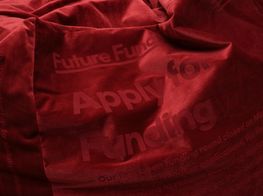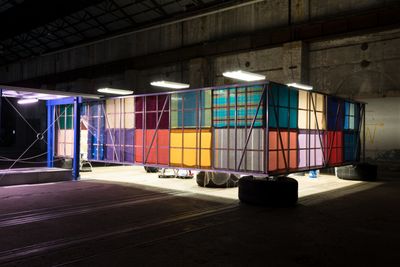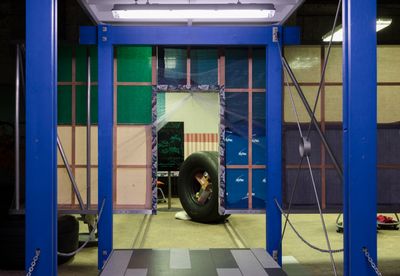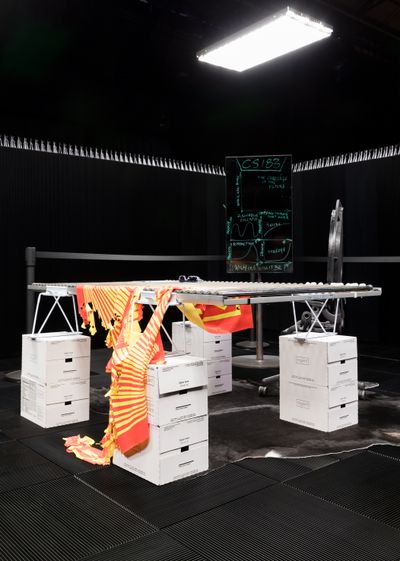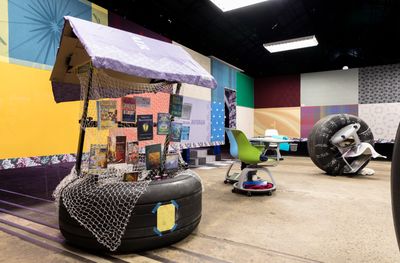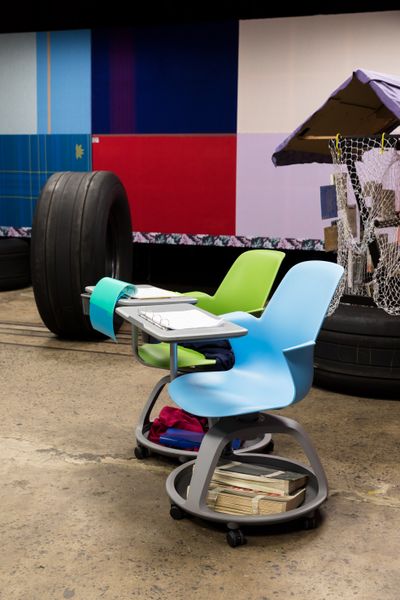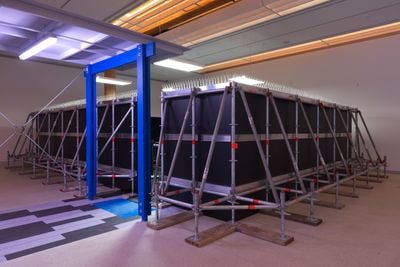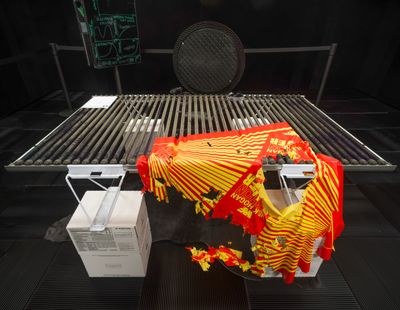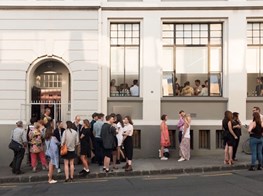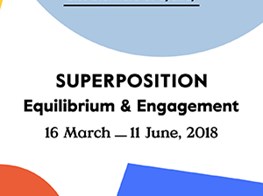Michael Stevenson
in partnership with the 21st Biennale of Sydney
Michael Stevenson, Serene Velocity in Practice: MC510/CS183 (2017). Mixed-media installation. Dimensions variable. Installation view: 21st Biennale of Sydney, Carriageworks, Sydney (16 March–11 June 2018). Courtesy the artist; Carl Freedman Gallery, London; Darren Knight Gallery, Sydney; and Michael Lett Gallery, Auckland. Photo: silversalt photography.

Michael Stevenson, Serene Velocity in Practice: MC510/CS183 (2017). Mixed-media installation. Dimensions variable. Installation view: 21st Biennale of Sydney, Carriageworks, Sydney (16 March–11 June 2018). Courtesy the artist; Carl Freedman Gallery, London; Darren Knight Gallery, Sydney; and Michael Lett Gallery, Auckland. Photo: silversalt photography.
At the centre of Michael Stevenson's art practice is a sustained investigation into objects that give form and physical expression to broad ideological, economic and political forces. The New Zealand-born, Berlin-based artist is known as a maker of detailed research-based sculptural installations. With characteristic dry wit and an acute eye for the telling detail, his works excavate the ironies of history through close attention to its relics and artefacts. Stevenson's This is the Trekka (2003), commissioned for New Zealand's pavilion at the 50th Venice Biennale (12 June–2 November 2003), took the form of a trade fair stand presenting New Zealand's only locally made and mass-produced vehicle. While the Trekka was suffused with nationalist aspirations towards economic self-sufficiency, and even stimulated wild fantasies of international export, Stevenson's installation pointed out that its mechanical parts were actually imported as kit-sets from the Czech automobile company Škoda. At the height of the Cold War it seems the engine of capitalist industry and economic independence was quite literally imported to New Zealand from Czechoslovakia.
Stevenson's projects regularly centre on meticulous reconstructions of historical artefacts, such as the laboriously reconditioned Trekka he exhibited in Venice or The Fountain of Prosperity (2006): a monstrous, fully functional hydro-mechanical economic computer that replicates a machine once owned by the Central Bank of Guatemala. Originally developed by New Zealand economist Bill Phillips in 1949 as a dynamic model of a national economy for use in the classroom, the machine was known as the MONIAC. It effectively endowed the economy with a visible body, complete with circulatory system and internal organs. Stevenson's The Fountain of Prosperity is presented in a state of ruinous collapse. It indexes the deep currents—economic, political and ideological—that coursed through the original computer's historic sojourn in a Central American economy.
Stevenson always approaches his subjects with a sculptor's sensitivity to the material forms in which the ebbs and flows of history take shape and take effect. In his exhibition Signs & Wonders at Kunsthal Charlottenborg, Copenhagen (21 November 2015–21 February 2016), he investigated the 'faith-based aviation' of airlines operated by missionary groups in remote regions. Extending the logic of the sculptural double that centres his practice, Stevenson built a number of flight simulators. The simulator units, grouped together as if constituting a flight school for trainee pilots, repetitively performed virtual training flights over a computer-generated model of highland Papua New Guinea. The physical form of the simulators, bringing together the practicalities of the missionary imperative and the transcendent possibilities opened up by technology, linked the aspirations of both technology and belief.
For this conversation, I spoke with Stevenson about his recent installation, Serene Velocity in Practice: MC510/CS183 (2017). Currently on show at Carriageworks for the 21st Biennale of Sydney (16 March–11 June 2018), the work was first exhibited at Auckland Art Gallery Toi o Tāmaki (12 November 2017–6 February 2018), and will be shown at Melbourne's Monash University Museum of Art | MUMA in 2019.
APSerene Velocity in Practice: MC510/CS183 stages an unlikely juxtaposition of two university courses that were taught at different times in California. MC510 'Signs and Wonders' was taught by Evangelical pastor John Wimber at the Fuller Theological Seminary, Pasadena, from 1982–86, and 'Startup' CS183 was taught by Silicon Valley billionaire Peter Thiel at Stanford's Computer Science faculty in Berkeley in 2012. You've made a two-classroom campus that physically brings these very different courses together. For you, is it a case of comparing apples and oranges or are there definite connections between them?
MSI think of the campus structure I've developed as some kind of learning environment; it's not exactly clear it really can be credited as a university. Both these courses were developed outside of academia, in industry. Both have been very influential outside academia, and now exist in other learning formats—books, workshops, business models, etc.—that sit beyond the university, and as a number of subsidiary courses. It's unclear which iteration they're presented in here or who'd really be teaching them.
I see the two courses as beginning from the same premise: something's wrong. This then is followed up diagnostically: what's wrong? Something's wrong so it needs to be fixed or restored. You see this underlying public statements from Thiel; for example, his well-known complaint about the state of contemporary technology: 'We wanted flying cars, instead we got 140 characters'. It's visionary, however it also suggests an entire worldview. In Thiel's world, further questions such as why we're in this state—attributions of blame—seem actually to be answerable. It's a form of problem solving that sits very uncomfortably in academia.
APThiel's and Wimber's courses had this visionary element and, as you say, they both also had an approach to education that was more oriented towards practice than theory.
MSThiel also funds a fellowship for young people as a counter to higher education. Its purpose is to encourage the best and brightest to go out and start a business instead of enrolling at university: 'to build new things rather than sit in a classroom.' That's a very clear example of his approach, and it has to do with a difference between knowing and doing and what he sees as the limitations of the classroom environment.
APThiel's course centred on the question of why some business start-ups fail and others succeed. Can you describe Wimber's class?
MSEach class began with about an hour-long lecture and after this he'd say, 'OK, now let's have a clinic.' That's what he called the second part of the class. He would then ask the students, 'Does anyone have any ailments today?'
APAnd what would happen next?
MSSomeone would put up their hand and say 'I have this sinus problem', or 'I've had a toothache', or whatever, and then the classroom would become an experimental site for faith healing.
APThe whole class would participate in this?
MSWimber's line was 'everybody gets to play'. So, it was done en masse, it was bodily and chaotic. But it's important to know that Wimber didn't invent this stuff. He was teaching in a faculty at Fuller called the School of World Mission and Church Growth, which began in the 1960s. What they did was analyse missionary accounts from the developing world as a form of conservative anthropological fieldwork. They were interested in what they called a 'power encounter', where 'the old gods meet the new god and find their powers diminished.' It's actually similar to what Thiel calls 'last mover advantage'. The whole idea is that this power encounter was done quite publicly in these communities. So that people can see. It's like a demonstration of strength.
APSo, these Western missionaries were going out and staging these power encounters in various developing countries. It sounds very combative, and almost like a colonial methodology, actually.
MSYeah. For mass conversion. Terrifying stuff. So, this had gone on at Fuller before Wimber arrived. But one of the things that became apparent in those early years, in the 1960s, was that in the places where the missionaries were working it was totally normal for people to talk about evil spirits, for example. And that was not true in America at that time. The missionaries noticed this, and realised that somehow a new spiritual awareness had to be reintroduced to contemporary America. If sickness was the problem that needed to be fixed, then its diagnosis now involved the spirit world, and that's how these prayer intensives for healing could flip out into exorcisms.
APSo, in a way, it was reverse colonialism too, with non-Western religious practices influencing what was happening in the US. And this is what Wimber was putting into practice.
MSYes, it's also an early example of how the periphery comes back to affect the centre. I should mention that Thiel was also raised in an evangelical world and irrespective of his move away from this religious worldview he maintains some kind of mission imperative.
But this faculty at Fuller wasn't just the School of World Mission, it was the School of World Mission and Church Growth. These were tools to create growth. CS183 has the same directive. How do you grow a successful start-up? How do you grow a business? It's all about growth.
APIt also seems to be about how theory takes effect in the world. The students seem to have been tasked with a mission, for want of a better word.
MSYes, they're literally part of an experiment that's based in this worldview where there's a problem and it has to be fixed. That's their mission.
APSo, the classroom became a place of indoctrination?
MSI think it's unavoidable. In both cases.
APSerene Velocity is also the title of an experimental 1970 film by Ernie Gehr. What do you see as your work's connection with Gehr's film?
MSAround 2001 I was teaching and living in Los Angeles and met the filmmaker and artist Morgan Fisher, and from this time structural film has been quite influential on my practice. Serene Velocity was filmed in an educational institution's corridor, and I took cues from this while developing my project.
APThe two classrooms in Serene Velocity in Practice are also connected by a corridor.
MSThe corridor I built is really a covered walkway. It's quite skeletal, more like a sketch or a drawing than a fully present internal space. It's modelled on a structure that's typical of educational institutions. In my campus it functions in much the same way as the camera lens in Gehr's Serene Velocity. In the film the lens links an actual corridor at the State University of New York in Binghampton with the darkened space of the camera body itself. My walkway physically links the two classrooms, and it also acts as a focus and a zoom. It draws the classrooms together, like a lens, even though they're set quite a distance apart.
APGehr used a stationary camera and rapid shifts in focal depth to create a pulsing back-and-forth movement that compresses space and time quite violently.
MSThe set-up of my work teases out some of the inherent differences between film and sculpture, but, like the film, nothing actually moves except the viewer. My piece is spread over some 30 metres, so it's not possible to experience both classrooms at once. By the end of Gehr's film, the viewer has actually been situated at every point along the corridor, but transitions between each of the positions are abrupt and discontinuous. The zoom adjustments all happen in the mystery spaces between frames. They begin quite minimally but increase in intensity until the entire corridor is explored in a single leap.
APCan we talk about the objects and materials you've used in the classrooms? They're not exactly standard-issue classroom furniture.
MSIf the walkway in my piece is the lens, the classrooms could be thought of as projections. There's lots of what I'd call shifts or jumps. So, materially speaking, the viewer is placed in an environment that speaks somehow of the course, even though none of what they're looking at would have been present in the original classroom contexts. Instead, the result is something much more material: less stable, more experiential and more unhinged.
In the broadest sense you could say that the material in my classrooms comes from industry rather than academia—that's the first jump. This dissociation with our understanding of what a classroom looks like mimics the tension built into both courses: is learning more knowing or more doing? Each object or group of objects is based on a module from the course; I think of them as resource boxes. It's a process that's still developing. If you saw the installation both in Auckland and then again at the Biennale of Sydney you will notice that additions have been made.
APCan you give me an example of these modules, based on what you have developed so far?
MSPart of CS183 was a study of what Thiel calls the 'clean tech bubble'. At the time, there was a lot of California-based innovation in solar energy, much of it was supported by government subsidy, and most went bankrupt. Thiel refers to these deceased companies as 'green ghosts'. His analysis of them is really a veiled attack on Obama's policies. So I've used a CIGS cylindrical solar cell made by the Silicon Valley start-up Solyndra, which filed for bankruptcy in 2011, and this now becomes the most prominent desk in the CS183 room. It's Thiel's case study in start-up failure, complete with auction house lot number.
APAnd the solar panel rests on stacked boxes of a product called Soylent. Is it protein powder?
MSIt's actually described as 'meal replacement'. It's a way to eat without ever having to leave your desk. Soylent has a fantastic slogan: 'free your body'. But the implication is free your body from food. It's the only company represented in the classroom that isn't yet bankrupt.
APA lot of the objects and materials you've used have something to do with energy. The solar cells store energy, for example. You've lined the whole interior of the CS183 room with heat sink, which is used to stop computers overheating, and the MC510 room is lined with blankets. It feels very bodily to me.
MSYeah, I think the aircraft tyres in MC510, for example, are also objects with lots of excess energy. They're very violent, they've been through all sorts of extreme processes during takeoff and landing: heat, friction, pressure, et cetera, over and over again. They're very energy-filled, and a trace of this remains. Once they're scrapped, these tyres are called carcasses. So they're also very bodily.
APThe chairs in the CS183 room are also quite unusual.
MSThey are sculptures that I think of as both chairs and bodies, though really they function as neither. The legs, feet, armrests are standard: Herman Miller's Aeron design. This was a chair whose aesthetic defined the 1990s and the dotcom boom. It has succumbed to another shift here. The Aeron already had the pretense of being a throne, but now a round plastic manhole cover replaces the seatback. The sense of entitlement the original chair was famous for now becomes bombastic.
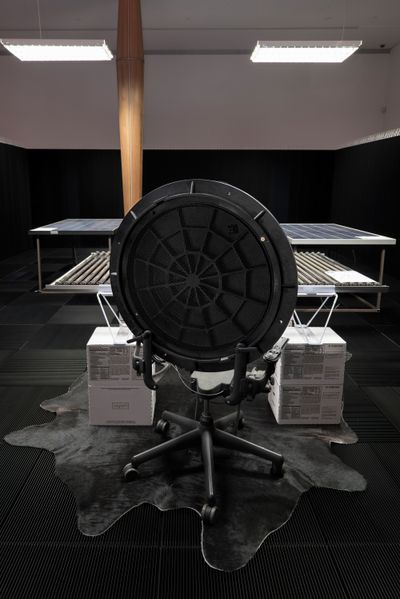
APWhy a manhole cover?
MSThere are a few reasons, but one is that I wanted to refer to these strange games, brainteasers, that have become a regular feature of Silicon Valley job interviews. In a sense, the interview format fails in the same way as the classroom: it demonstrates what somebody knows, not what they can do. So these brainteaser questions were introduced as practical problems to solve. One of them is simply 'why are manhole covers round?' This brings a practical element into the interview. Thiel uses them; IBM has been using them since the 1950s.
APSo this is a way for the interviewer to witness problem solving and practical thinking first hand?
MSIn real time, yes, exactly. But I also think the chair is offering something else: protection. It seems bulletproof, a barrier against violent market volatility, even the apocalypse, but importantly the protection afforded is just for one—a single entity.
APThe idea of the double or alter ego features regularly in your work. Do you see Wimber and Thiel as alter egos? And how does Hulk Hogan fit in?
MSLike a number of the characters I've worked with before, Wimber and Thiel are visionary figures. They excel in several fields, which perhaps gives them the appearance of having multiple personalities.
One thing I unearthed while researching the MC510 course was a VHS tape of 'Sybil', the 1976 TV mini-series. Apparently, this infamous case of multiple personality disorder (what's now called Dissociative Identity Disorder) was studied in the MC510 class in order to try to understand the condition as a form of demon possession. This dubious re-diagnosis, using a case study filtered through Hollywood drama, and in the context of an accredited academic course: well, it was fascinating, and I wanted to work with it. Perhaps we could think of Wimber and Thiel as dissociative personalities instead of separate characters.
APAnd Hulk Hogan?
MSI see Hogan as some kind of original folk hero. Thiel dressed as him for a costume party in 2016.
APReally?
MSWell, according to Reuters. This was soon after it was revealed that Thiel had secretly funded Hogan's lawsuit against the now-defunct Gawker blog. They'd posted compromising footage of Hogan with his best friend's former wife. This then becomes the clearest case of dissociative personalities: Hogan's off-stage name is Terry Bollea. Hogan's legal team argued that while Hogan is a public figure, Bollea is not and Bollea was the personality that appeared on the tape. So it was successfully proven in court that they are two different personalities.
APWhat was Thiel's motivation? Why did he fund this court case?
MSI guess he saw Gawker as the worst of what an independent media could deliver, and in many respects it was, but again this position reveals a wider worldview. Thiel is a libertarian, and he believes that technology—and, by extension, the entrepreneurs of Silicon Valley—is really the only thing that matters, the only thing that will save us. There's no place for an independent or critical media in his ideal of a free-market meritocracy.
The Hogan case sets an important precedent. I used one of his bandanas in the CS183 room, but it's shifted in terms of material and scale. Mine is larger and printed on very thin latex.
APWhy latex?
MSIf you immerse latex in cryogenic nitrogen it freezes solid and you can smash it. It's no longer flexible, it smashes like ceramic. I took my bandanas to the chemistry department at The University of Auckland, froze them to -200°C, then I wrestled with them and smashed them.
APYou wrestled with it?
MSYes, I wrestled it, tore holes in it. The effect is very weird, almost like lace.
APIt also looks like it's been attacked by an animal or something.
MSYeah. It's violent. —[O]

